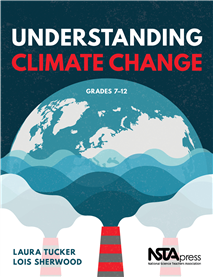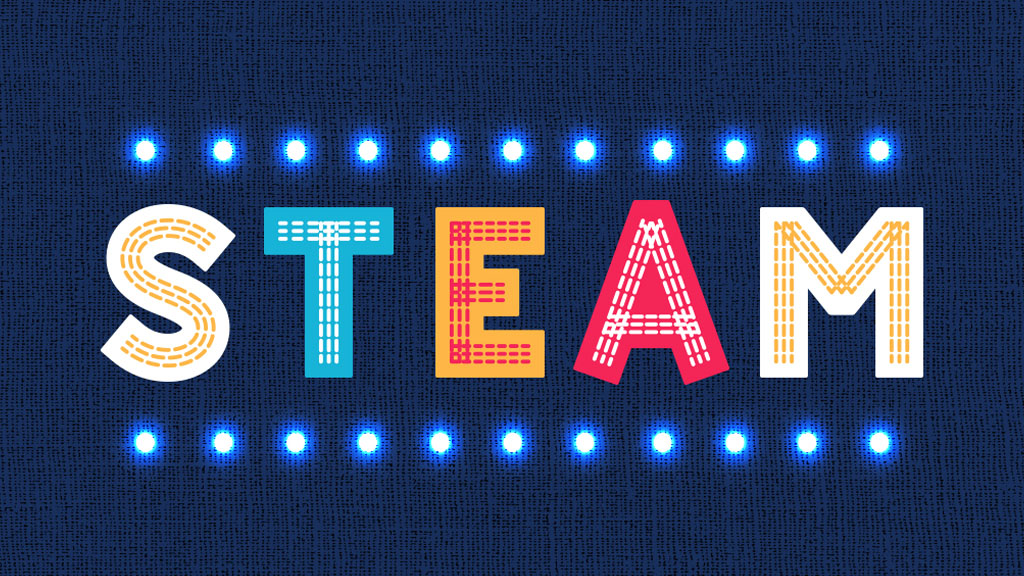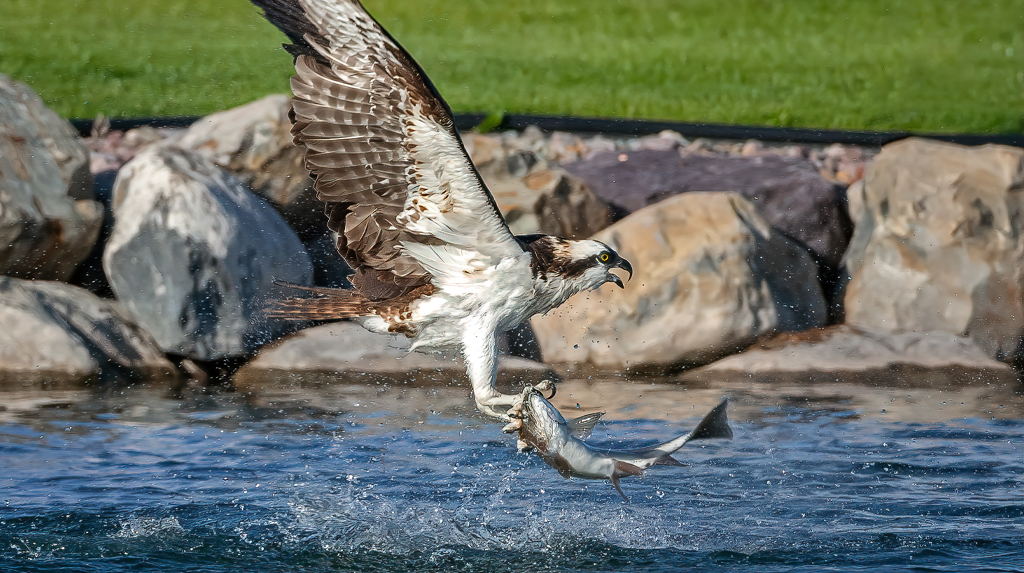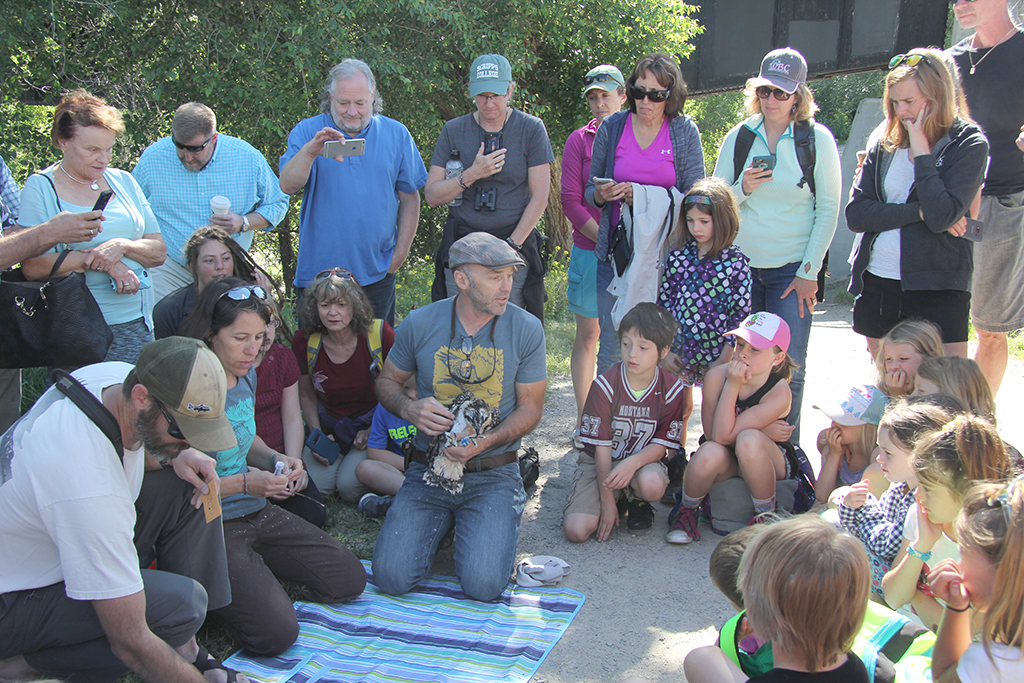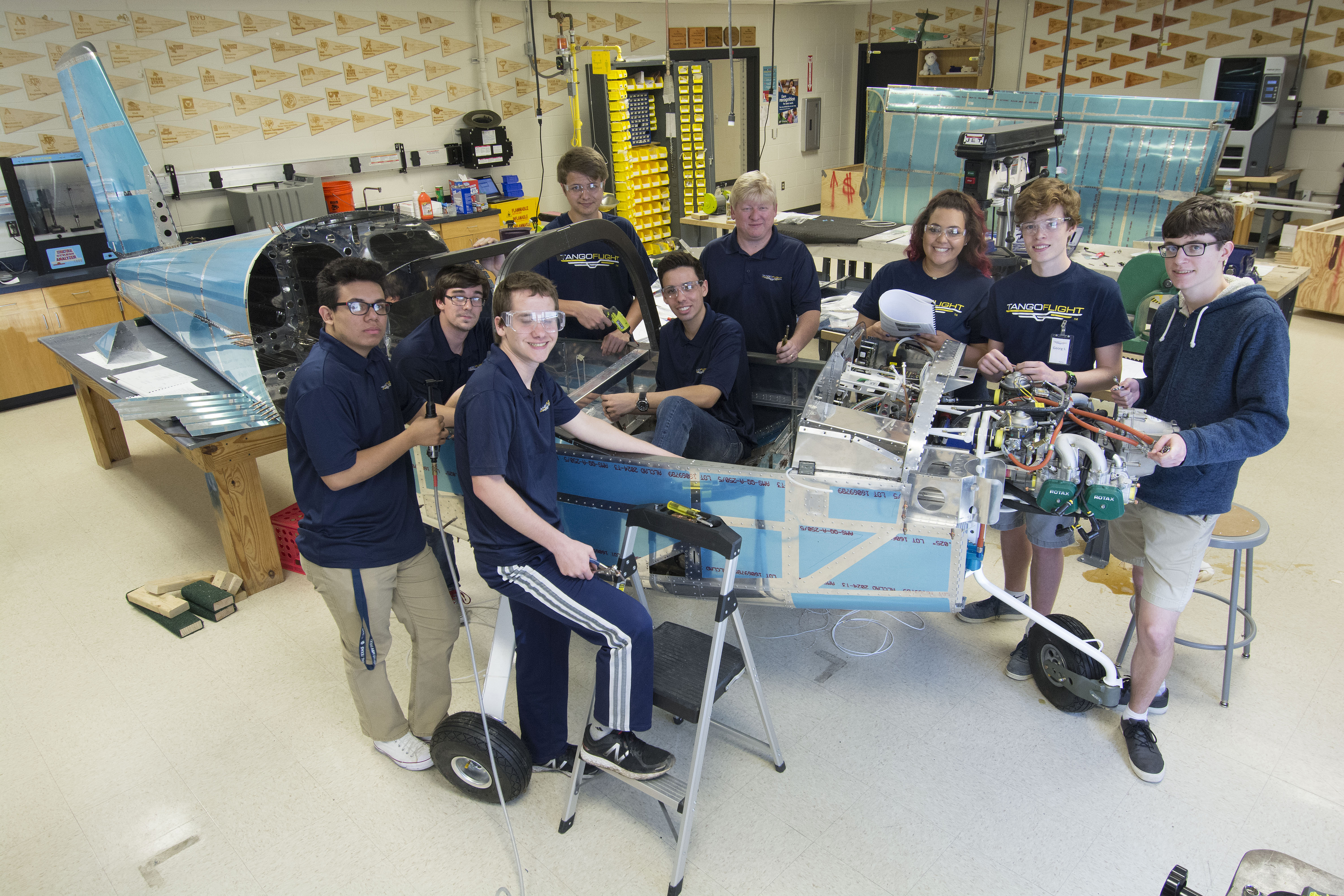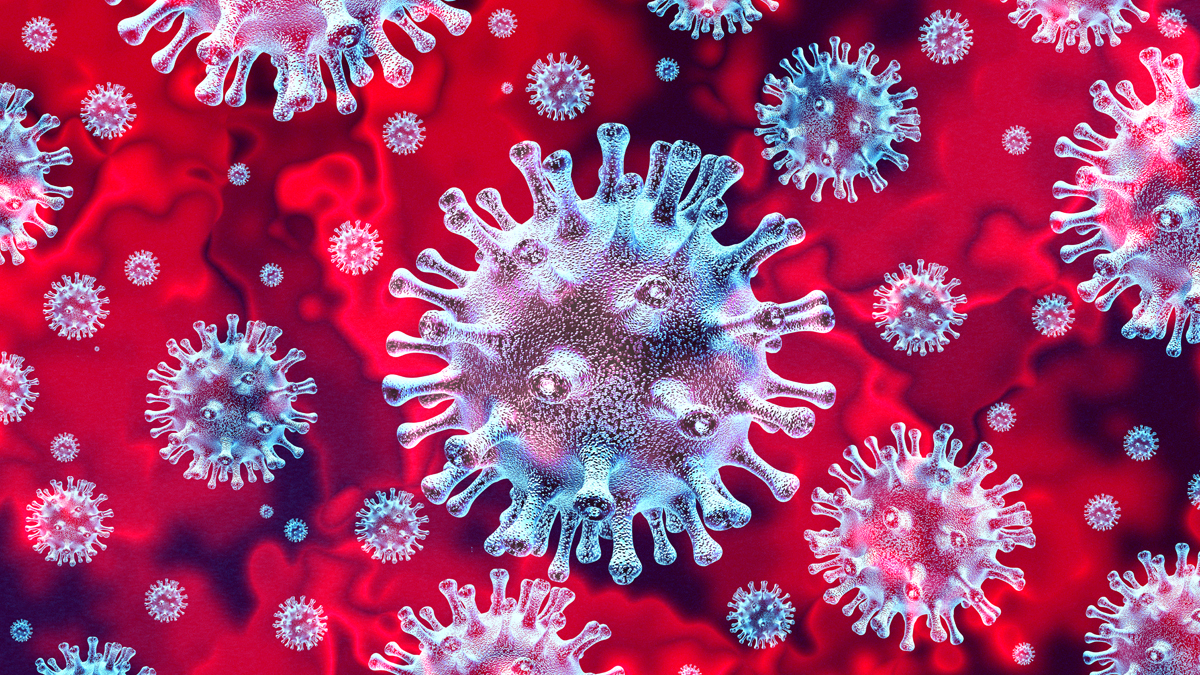Tell the story of an important event that happened in your family. Tell the story of a place that is important to your family. Tell the story of how your family or the world will change in 10 years.
With these prompts, TechTales invites families to tell and animate their stories using robotics components and everyday materials. Over the course of five weeks, families build a diorama that depicts a scene in their story. In the first two sessions, families brainstorm a story they would like to tell using one of the three prompts listed above. They choose a scene in the story they would like to build into a diorama using cardboard boxes, construction paper, and recycled plastic (see Figure 1). In the second and third sessions, they learn about how to program robotics components, such as making an LED light blink or controlling a servo motor. TechTales provides families with a Hummingbird robotics kit, which includes a circuit board, sensors, motors, and LED lights. Users can build projects with everyday materials and program them using Scratch and other programming languages. In our project, after families decide on their story and design their diorama boxes, they build and program those boxes during the third and fourth sessions. Finally, families present their dioramas in a community storytelling event during the fifth session of the workshop (see Table 1 for an overview of the program).
In this article, we share our design principles and process, findings from our research on TechTales, and the structure of our partnership—as well as how TechTales supports a STEM (science, technology, engineering, and math) mindset in families and project staff.
Table 1
Overview of TechTales sessions

TechTales is part of a larger National Science Foundation–funded four-year partnership between the University of Washington, the Pacific Science Center, the Seattle Public Library, Red Eagle Soaring, and the Highline School District Native Education Program. We have created a series of family STEAM (science, technology, engineering, art, and math) workshops centered on family storytelling and redefining families’ relationships with technology. There are two programs within our project: TechTales and TechStyle Tales. While TechTales connects families’ stories to robotics, TechStyle Tales connects family stories to e-textiles. In TechStyle Tales, families use conductive thread to sew LED lights and sensors onto textile projects (aprons, blankets, tote bags) that tell a story. The LED lights are programmed so that the lights flash in patterns or in response to input from sensors on the board. TechStyle Tales follows a similar structure as TechTales, emphasizing family storytelling in the first two sessions, coding and project building in the second two sessions, and sharing in the fifth.
In both TechTales and TechStyle Tales, we start with one of the oldest human technologies, storytelling (Archibald 2008), and build connections between families’ lived experiences, engineering, robotics/e-textiles, and computer science. We have found that stories are the grounding for family members to work for hours to achieve a certain “twinkle” effect to mimic stars in the night sky, or to experiment with how to make an owl’s head turn. This perseverance, innovation with technology, and deep connection between engineering and families’ personal histories and stories are hallmarks of both programs and integral to program goals of building a STEM mindset.
All together, our programs have served over 65 families—almost 200 participants over the life of the projects. We conducted research on families’ interactions and learning during the workshops to understand the role that storytelling, cultural practices, and family knowledge played in family engineering practices. We collected data by recording video of families during each workshop session, documenting their projects and final storytelling to the community, and interviewing families. As a result, we have over 15 hours of video data from each family, along with pictures of each of their final projects. The vignettes that follow are from that video data corpus. In addition, our evaluator administered surveys to all workshop participants (adults and children) after each workshop session and interviewed all of our partners about the program. Qualitative evaluation findings are incorporated throughout the sections that follow. As we share our findings from our research and evaluation, all of the names of facilitators, families, and family members are pseudonyms that participants themselves chose.
We have used a participatory design research model (Bang and Voussoughi 2016) to codesign and cofacilitate our program (Tzou et al. 2019). This means that, rather than one partner—for example the university—designing the program for the library, community, or partner school, all of the institutions codesigned alongside each other. In this way, we designed a program that truly addresses each partner’s needs. A core design group made up of members from all partner organizations met regularly to brainstorm, prototype, and design the program. When one of our program sites involved a low-income housing organization, case workers who deeply knew the families were also part of the design team.
We recruited children’s librarians and other practitioners to facilitate the program and codesigned professional development to orient these new facilitators, who did not need any previous engineering, coding, or making background to run the workshops. Because children’s librarians and educators in the Native Education Program had close relationships with the communities in which they work, they recruited families into the workshops, which were capped at five families (or 20 people) per session. Although learners of all ages were welcome, we encouraged families with children ages five and older to attend. The programs were free for all participants, and childcare for younger siblings and dinner were provided. To support the whole program team’s learning during implementation, we designed a way to regularly check in after each workshop session (see the “Trust the Process” section below) to continually improve the design and pedagogy of the program and learn from each other and the participating families. We have codesigned a complete set of facilitator’s guides to capture the activities, pedagogical strategies, and structures of both TechTales and TechStyles Tales family workshops.
The evaluation found that members of partner organizations said the following about our collaboration:
- “This is such an interesting and unique example of a partnership. The power sharing that’s going on; seeing how just in many different ways that we’ve been able to plug into each other and work for the project.”
- “I think it gets messy but a big takeaway is … it’s important to involve all of our partners equally with an equal footing [at] the table and having them have a voice about what is design.”
- “A commitment from all to see each other as partners—as experts and as collaborators—instead of competitors or as obstacles. I think that sometimes when we partner with others, we may see their interest or their missions or their goals as obstacles to our own. But I don’t get the sense of that happening here at all.”
- “This kind of real integrated deep partnership is just something that I really have not observed or been a part of.”
Design principles: Building STEM mindset through culturally based family STEM learning
Other hallmarks of our program are the foundational principles about learning and equity that drive our design (Tzou et al. 2017; see Figure 2). In this section, we describe four of these design principles and illustrate each in action with a vignette from a participating family. These principles are grounded in research in the learning sciences that shows the rich and varied ways that families learn outside of school (Banks et al. 2007), as well as the importance of understanding the role that culture and identity play in learning (Nasir et al. 2006).
We begin with the idea that all learning is cultural. A Framework for K–12 Science Education argues that, “All science learning can be understood as a cultural accomplishment … What counts as learning and what types of knowledge are seen as important are closely tied to a community’s values and what is useful in that community context” (NRC 2012, p. 284). Therefore, we understand that families bring their histories, languages, experiences, and values into learning settings—and we designed TechTales to make space for those ways of knowing.
1. Promote multiple ways of knowing and making
We designed our programs in a way that did not assign value to different ways of knowing and making. There was no one “right” way to make or learn—families engage in projects in many ways based on the knowledge and expertise they bring to the program. While the facilitators often supported families in building their stories, the intergenerational nature of the program also made space for parents to act as facilitators and center their own family and cultural knowledge in story-building and making. In this way, multiple areas of expertise and interest can intersect with STEM learning, even if the program facilitator is not necessarily familiar with each family’s cultural practices.
While brainstorming their story, the Pony family, a Native family from the Seneca-Cayuga Nation, had a conversation about their child’s first lightning storm. During the conversation, Corey (the father) and Tracy (the mother) ask Gwen (the child) some questions about the lightning storm:
Corey: What story would you tell your kids, Gwen?
Gwen: Lightning storm.
Tracy: Lightning storm? Okay.
Corey: That would be a good one because you could do like … with LEDs behind it. Gwen’s first big lightning storm. A real one.
Gwen: Scared lightning, it makes me scared.
Corey: So what do you remember of that storm? How did you feel about the storm?
Gwen: Scared.
Corey: You were scared? And? What—did you smell anything, hear anything? See anything? Did you see it?
Gwen: Boom.
Corey: You heard it? Was it so loud you could feel it?
Gwen: No. Scared.
In this example, Corey teaches Gwen about how to tell a story and how to observe the land. By asking the questions about what she smelled, heard, saw, and felt, he is embedding Indigenous ways of knowing through stories (Archibald 2008) and relating to the land through observation (Kawagley, Norris-Tull, and Norris-Tull 1998), all while he is thinking about how to use robotics components (e.g., LEDs) to depict the event (see Figure 3). This example shows how, when activities are designed to make space for families to connect to multiple ways of knowing rather than being prescriptive about what to build and how, families have opportunities to connect to their cultural practices in engineering learning environments.
2. Scaffold playful thinking and teaching
Families learn through playful and collaborative exploration of concepts and materials. Learning is not about step-by-step sequencing, but rather about creating depth and space for play and creativity with materials. To that end, we wanted to design experiences to make learning new skills, such as wiring, programming, sewing, and robotics, fun and engaging.
During one workshop activity in which families learn about algorithms, kids “program” adults to do things: walk around the table, sit in a chair, or walk in a straight line while avoiding a tree. In this way, they learn how detailed and specific their “code” needs to be for the “robot” to perform a task. They also learn about how to “debug” their code and keep trying until their robot family member correctly performs the task . In the Lee family (one mom and two sons), the older son programmed his mom to “do the happy dance.” His mother jumped up and down and waved her arms, much to her son’s delight. When it was the younger son’s turn to program his older brother, he had a “happy dance” in his program, too!
When we designed TechTales, we wanted learners to playfully learn together within and across families. We found that playful learning allowed families with children from wide age ranges to participate in the activities. We also found, as in the example from the Lee family, that playfulness helped flip traditional roles. In this case, the playful programming of the parent allowed the sons to be “in charge” of their mom, and the younger son to give commands to his older brother.
3. Learning experiences should grow out of the lives of learners
Families can relate technology to their lives in meaningful ways rather than program facilitators letting technology define their experiences. The ways families design and create their projects can be deeply personal and filled with family history and community goals. In TechTales, we create space for families to bring their own learning pathways, experiences, and interests into STEM learning. The overarching goal is to overlap the STEM learning with the lives of families and their communities.
The Wanbli family, a Native family who is Lakota, Paiute, and Mayan, chose to tell a traditional story about how the inipi (sweat lodge) came to the Lakota people. As one of the sons, Yoshi, programmed an LED light, he worked with his father, Charles, to recreate the medicine wheel with accurate colors placed in the correct order. As they work together, their talk switches between English and Lakota languages:
Yoshi: Ooh, wait! The yellow looks way better in here. Oh that’s right, the white in here.
Charles: I think the blue—blue I think shows the most. Nah. I think the blue showed up, which is fine ’cause that’s actually the first direction.
Yoshi: Wait. What order does it go in?
Charles: Blue, red, yellow, white.
Yoshi: What’s after blue?
Charles: Huh?
Yoshi: What’s after blue?
Charles: Shah.
Yoshi: Red. What’s after red?
Charles: Zi.
Yoshi: Yellow. And after yellow is white?
Charles: Uh-huh.
This is an example of how, while working with the LED lights to tell a meaningful cultural story, the family uses Indigenous knowledge systems embedded in the Lakota story and language to create a specific effect with the lights. After this interaction, Yoshi iterated his programming of the lights to reflect his conversation with his father (see Figure 4). This shows the importance of designing activities that allow learners to draw on their own life experiences for learning and creative engineering.
4. Broaden what counts as STEM using everyday and professional forms
STEM learning environments often work within very narrow and overly uniform views of what counts as STEM (Warren et al. 2001; NRC 2012). When family stories are at the center, new forms of STEM learning emerge—sometimes in unexpected ways. In TechTales, we broaden definitions of STEM and create opportunities for new forms of participating in and learning STEM.
The Diamond family built their diorama around a trip that they took to “family camp,” depicting their cabin under a night sky filled with stars. One challenge they encountered was how to program the LED lights so that they would “twinkle” like stars. In one workshop session, Command Block, the older son of the family (age 9) spent two hours experimenting with how to program a multicolored LED light to be the desired color and twinkle in a way that would resemble a star (see Figure 5). He worked with a program that his dad started and tried to refine it. After a couple of hours, he asked his dad (John), “Dad, do you know how I can make this [the light] faster? Stars don’t really twinkle.” John looked outside the window at the night sky and replied, “Yeah, I mean like ever so faintly because of the air, the differences in temperature in the air. Yeah, they don’t really. But if they’re just static in the box, it won’t look quite as cool as if there’s something happening.”
As they tried to re-create a memory and program a certain effect into their project, the family started to explore the reason why stars twinkle. It is not hard to imagine this becoming the basis for a much longer or more in-depth conversation into space science—or Command Block recalling something about stars twinkling in his space science unit in school. This also helps us understand that everyday knowledge about ideas such as stars twinkling may be embedded for learners within these kinds of complex networks of everyday practices, stories, memories, and experiences. Providing opportunities in programs for learners to connect to these networks of knowledge is an important way for them to use their rich everyday knowledge in learning science.
Fostering a STEM mindset
Building community
A safe and supportive community was key for a STEM mindset to flourish. All of our workshop series started with dinner and “About Me, About Us” cards. This was a chance for families to share a meal and introduce themselves to the group. The cards asked each family member to write something they like about themselves and something they like to do. They switched cards with someone and then introduced this person’s card. We held workshops in school-affiliated programs for Native American families, in low-income housing centers, in neighborhood community centers, and at Seattle Public Library and Pacific Science Center locations. Across all of these settings, these introductory activities were important for getting people comfortable, growing community, and getting people ready to engage with our programming (see Figure 6).
Grounding learning in storytelling
We recognized that stories and storytelling are a universal experience (Cajete 1994) around which the community could come together, talk about themes of the day such as perseverance or learning from mistakes, and refer back to as they did their work.
We started off every workshop session with a story and used stories in different ways depending on the workshop settings. In some settings, librarians selected books that highlighted relevant concepts such as perseverance, curiosity, innovation, and learning from failure, which we could refer to later by saying, for example, “Remember how in The Most Magnificent Thing,[1] the main character keeps needing to redesign her project, too?” We also built on the Pacific Science Center’s strengths by bringing in STEM professionals from the Portal to the Public program to tell stories of “science failures,” including a family favorite in which a marine biologist’s data made no sense until eventually she realized that a snake from a nearby area was climbing out at night and eating the fish in her experiment! In our partnership with Native education programs, traditional storytellers were invited to share community stories that contained lessons about the importance of family, self-confidence, science practices, and learning from mistakes and through teaching others (Archibald 2008; see Figure 7)).
[1] This refers to Ashley Spires’s 2014 book, The Most Magnificent Thing (New York: Kids Can Press).
Try something new
Once we built community through storytelling, we introduced new concepts and got families out of their comfort zones to try something new. In TechStyle Tales, families learned and practiced sewing because they would ultimately connect conductive thread to lights to tell a story. Sewing and e-textiles were ways to connect to deep expertise of families, once resulting in a mother-daughter pair teaching and reteaching each other. The daughter knew a lot about patterns and design and the mother knew about the fundamentals and technique. It became a moment to learn from each other before they also helped members from other families. Participants from multiple families would often gather around one person who had expertise in sewing to learn from them. In partnership with the Native Education Program, we also facilitated during in-school sessions the practice of integrating circuitry with beadwork from multiple Native nations’ traditions. By introducing STEM practices into beadwork, we were able to broaden what “counts” as STEM in school. In the evaluation data, when asked if the sessions helped them better understand electrical circuits, programming in Scratch, using motors and LEDs, creating loops in programming, and creating “if/else” statements in their code, the average rating for postworkshop survey statements was 4.5 out of 5, with 1 being “not at all” and 5 being “a lot.”
Define STEAM roles and identities
A key component of the workshop series was explicitly identifying STEAM roles and identities, such as computer scientist, researcher, electrical engineer, or storyteller. As facilitators, having an awareness of the roles and identities that are possible in our program helped us name them in action as we saw learners engaged in them. For example, when a child created a program that caused an LED flicker to create a campfire, the facilitator could say that they were thinking like a computer scientist. This was a powerful way for facilitators and families to make connections between their activities in our program, the professional practices associated with different roles/identities, and their everyday lives. It also makes clear that there is substantial overlap between the different roles, and made it possible to highlight practices found in multiple roles, which enabled learners to identify with roles that had previously been unfamiliar.
We used STEAM identities as a tool for in-the-moment facilitation and reflection. We closed each workshop session by asking family members what practices they used and which STEAM role(s) they identified with. We then awarded them badges as buttons or stickers (see Figure 8), representing the roles they took on that day. Ultimately, this was a powerful tool for fostering a STEM mindset. As many aspects of designing and building projects involved opportunities for families to practice 21st-century skills, learning from failure, and other elements of a STEM mindset, discussions of roles provided explicit opportunities to make aspects of STEM mindset visible for family members. We gave families a handout (Figure 9) as a tool for reflecting on how they might be thinking like artists, researchers, or electrical engineers, and to highlight overlap between roles. For example, “creative” is a characteristic in all of these roles. Through actively reflecting with facilitators and each other using these lists, participants identified new skills in themselves while directly making connections to how those skills could be applicable in the future. From the evaluation data, we could see that participants were identifying with these roles. Results indicate that when asked to rate on a scale from 1 to 5 (with 1 being “not at all” and 5 being “a lot”), family members said the workshops helped them feel like an engineer (4.61), computer scientist (4.59), and artist (4.59).
Trust the process: Building a STEM mindset between the partners
Finally, we realized that it was important to continually iterate the program to ensure that it fit community needs. This required that we develop a STEM mindset about our own work. Over time, we developed formal and informal tools to learn from failures in the workshop as an opportunity for growth.
We ended every session with a debrief including all facilitators, educators, support staff, and researchers. We always asked the same four questions (see Figure 10):
- Describe a high point for you today.
- Describe a low point for you today.
- Describe a snapshot of learning, including multiple ways that you saw people learning.
- What would you change for next time?
By deliberately looking at moments in which we saw learning, we all got better at recognizing learning as it happened. By looking at what did not go well, we created a safe space to collectively identify failure and what we could learn from it. In this way, we were able to course-correct with the same families the following week or with new families the next time. Through this group reflection, we made changes to everything from the way we presented information to the layout of the room, the tools we chose to have out, the way we offered support to participants, and the overall structure of the program—all from data we collected through our observations. By the end, we ran the program 19 times with over 65 families, and each time we were able to iterate and improve through this reflection process.
We also realized that we had taken on a STEM mindset in a more subtle way. Most of our workshop series were five sessions long. Inevitably by session four, the facilitators would slightly panic because it felt like families were so far from being finished that it seemed unfathomable that we would be ending just one session later. Over time we developed a saying: “Trust the process.” This took on two meanings. First, it was a reminder that we had done this before and we knew that families had made amazing projects in the past, so we could be confident it would happen again. The other meaning of “Trust the process” was to remind us to think about process over product. Without fail, every family told impactful stories through complex dioramas and e-textile projects. All of the facilitators were also blown away by the thought, learning, creativity, and personal and community connections that went into every project. If at the end of a series, everything in a family’s creation didn’t work perfectly, this would not be an issue as they still would have learned a lot, developed new skills, grown their STEM mindsets, and made connections to STEM careers, all while they strengthened family memories and relationships to their stories—which was more important than the end product, as intended.
Acknowledgments
We would like to thank the participating families in TechTales who shared their stories with us. This material is based on work supported by the National Science Foundation under grant number DRL 1516562. Any findings or opinions expressed in this material are our own and do not necessarily reflect the views of the National Science Foundation.
Carrie Tzou (tzouct@uw.edu) is an associate professor of science education and director of the Goodlad Institute for Educational Renewal in the School of Educational Studies at the University of Washington Bothell in Bothell, Washington. Daniel Rother (rother.daniel@gmail.com) was the Tinker Tank manager at Pacific Science Center during this project and now is the Understory program manager at the Seattle Spheres in Seattle, Washington. Ashley Braun (Ashley.braun@spl.org) is a children’s services librarian at the Seattle Public Library in Seattle, Washington. Elizabeth Starks (eestarks@uw.edu) is a research scientist with OpenSTEM Research at the University of Washington Bothell. Meixi Ng (meixi@umn.edu) is a presidential postdoctoral fellow in American Indian Studies at the University of Minnesota in Mní Sota Makoce. Enrique Suárez (easuarez@umass.edu) is an assistant professor of science education in the College of Education at the University of Massachusetts Amherst in Amherst, Massachusetts. Amanda Rambayon (arambayo@fwps.org) (Turtle Mountain Chippewa) is the Native education coordinator for Federal Way Public Schools in Federal Way, Washington. Philip Bell (pbell@uw.edu) is professor of education at the University of Washington Seattle. He holds the Shauna C. Larson chair in learning sciences. Don LaBonte (don.labonte@gmail.com) is a graduate student in the Learning Sciences and Human Development department at the University of Washington in Seattle, Washington. Amy Twito (amy.twito@spl.org) is the informal learning program manager at the Seattle Public Library, in Seattle, Washington. Shawn Peterson (shawn@naahillahee.org) (Nuu-cha-nuulth) is youth program manager at the Na’ah Illahee Fund in Seattle, Washington. Sara Marie Ortiz (Sara.Ortiz@highlineschools.org) (Pueblo of Acoma) is a writer; Native arts, culture, and education advocate; and the program manager of the Highline Public Schools Native Education Program in Burien, Washington. Megan Bang (megan.bang@northwestern.edu) is professor of learning sciences and psychology at Northwestern University in Evanston, Illinois.
 The Hubble Space Telescope (HST) was launched into Earth orbit on 24 April 1990 by the Space Shuttle. A flaw in the primary mirror initially made it look destined to be a historic failure. Space-walking astronauts made repairs and upgrades on five missions, and the resulting flood of outstanding science results made Hubble an epic comeback story.
The Hubble Space Telescope (HST) was launched into Earth orbit on 24 April 1990 by the Space Shuttle. A flaw in the primary mirror initially made it look destined to be a historic failure. Space-walking astronauts made repairs and upgrades on five missions, and the resulting flood of outstanding science results made Hubble an epic comeback story. The Hubble Space Telescope (HST) was launched into Earth orbit on 24 April 1990 by the Space Shuttle. A flaw in the primary mirror initially made it look destined to be a historic failure. Space-walking astronauts made repairs and upgrades on five missions, and the resulting flood of outstanding science results made Hubble an epic comeback story.
The Hubble Space Telescope (HST) was launched into Earth orbit on 24 April 1990 by the Space Shuttle. A flaw in the primary mirror initially made it look destined to be a historic failure. Space-walking astronauts made repairs and upgrades on five missions, and the resulting flood of outstanding science results made Hubble an epic comeback story. The Hubble Space Telescope (HST) was launched into Earth orbit on 24 April 1990 by the Space Shuttle. A flaw in the primary mirror initially made it look destined to be a historic failure. Space-walking astronauts made repairs and upgrades on five missions, and the resulting flood of outstanding science results made Hubble an epic comeback story.
The Hubble Space Telescope (HST) was launched into Earth orbit on 24 April 1990 by the Space Shuttle. A flaw in the primary mirror initially made it look destined to be a historic failure. Space-walking astronauts made repairs and upgrades on five missions, and the resulting flood of outstanding science results made Hubble an epic comeback story. The Hubble Space Telescope (HST) was launched into Earth orbit on 24 April 1990 by the Space Shuttle. A flaw in the primary mirror initially made it look destined to be a historic failure. Space-walking astronauts made repairs and upgrades on five missions, and the resulting flood of outstanding science results made Hubble an epic comeback story.
The Hubble Space Telescope (HST) was launched into Earth orbit on 24 April 1990 by the Space Shuttle. A flaw in the primary mirror initially made it look destined to be a historic failure. Space-walking astronauts made repairs and upgrades on five missions, and the resulting flood of outstanding science results made Hubble an epic comeback story.


